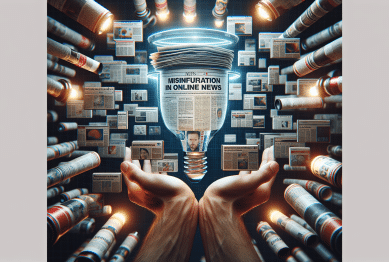AI ethics is making headlines everywhere, and for good reason. Explore how news coverage, regulatory shifts, and ongoing debates around artificial intelligence transparency, misinformation, and privacy directly impact society, policy, and daily online life.
How AI Ethics Became a News Sensation
In recent months, stories about artificial intelligence ethics have surged to the top of major news platforms. These headlines aren’t just about theoretical debates. They reach into real-world scenarios. AI is powering everything from news curation to live updates and digital ads. As this technology grows, public curiosity and concern intensifies. What’s fueling this rise? Many attribute it to the increasing integration of smart algorithms in everyday decision-making. As news organizations adopt AI-driven systems to spot breaking stories and optimize distribution, questions arise about objectivity, transparency, and bias. Not just a technology issue, AI ethics touches on journalistic integrity, the spread of misinformation, and the very way society interprets current events.
Major incidents have shaped the surge in AI ethics reporting. Reports of deepfakes, manipulated photos, and automated misinformation campaigns have repeatedly made front pages. These stories reveal how AI can shape narratives, influence opinions, and occasionally mislead audiences. Such events highlight the urgent need for ethical considerations in both creating and consuming digital news content. Because AI tools can process enormous volumes of information in seconds, they sometimes prioritize engagement over accuracy, amplifying sensational or polarizing content. This cycle has drawn the attention of global regulators, industry experts, and human rights organizations, putting extra pressure on media outlets to address the ethical implications of their technological choices.
Public response to AI in the news has been mixed. Some readers welcome innovation, noting improvements in news speed and customization. Others express caution, citing potential for reduced human oversight and increased bias. These voices are pushing for more visibility into how algorithms operate—what stories they highlight, which voices they amplify, and how decisions are made. This demand for transparency has become a key topic in editorials, roundtables, and policy documents. It’s clear that as the influence of AI continues to spread through media, so too does the expectation for accountability and clear ethical boundaries.
The Role of Regulation in AI News Coverage
With so many AI-powered stories hitting the headlines, governments and watchdog organizations are stepping in. Regulatory agencies worldwide are developing new guidelines to ensure AI technologies in newsrooms operate with fairness and responsibility. Some frameworks focus on preventing bias in news algorithms, while others guard against data misuse and preserve privacy in reporting. There’s also a growing push for independent audits of AI systems—ensuring decisions made by machines meet legal and social standards. These regulatory efforts are not only reshaping newsroom operations but are influencing how stories about AI ethics develop across major news sites.
Lawmakers in North America, Europe, and Asia have intensified debate over AI accountability. Discussions include whether news media should disclose when algorithms curate content, or how much notice readers deserve when encountering automatically generated articles. Public consultation periods have revealed widespread interest in greater clarity on these issues. Policy shifts are also evident at the industry level. Several leading news agencies have launched AI ethics boards, created new transparency portals, or joined international consortiums focused on responsible reporting and technical standards.
For the public, this regulatory momentum can offer reassurance, but it also raises more questions: Who defines ethical standards? How are violations detected or punished? What recourse do individuals have if harmed by AI-driven news errors? Media literacy organizations have responded with outreach campaigns, helping people understand what regulatory changes mean for readers and newsrooms alike. As the legal and ethical frameworks for AI in news continue to evolve, so too will the conversations about trust, fairness, and journalistic duty amid a complicated technological age.
Transparency and Trust in News Algorithms
Algorithms already influence which headlines, stories, and images appear in daily news feeds. This power brings convenience and customization, but also provokes hard questions. How transparent are these processes? News publishers, facing scrutiny, are exploring ways to make their AI operations more visible. Some outlets now publish guidelines explaining how stories are surfaced or prioritized. Others disclose the data sources and editorial rules guiding their AI. Transparency is no longer just a buzzword. It’s emerging as an industry standard.
Trust is difficult to earn and easy to lose. Readers recall past scandals involving algorithmic bias or data leaks, leading many to approach AI-driven news with skepticism. To address this trust gap, some organizations have instituted ethics reviews, open-source algorithm audits, and external advisory boards. These measures help answer questions and provide reassurance that AI use is monitored and continually improved. There’s growing emphasis on educating both journalists and the public about how automated systems operate and what built-in safeguards exist.
Readers also want more than technical disclosures—they want stories about the impact of AI. How does it affect newsroom diversity? Are underrepresented communities served or sidelined by AI systems? Where are the blind spots, and who is accountable when mistakes happen? By actively inviting these questions and making adjustments based on feedback, media organizations build trust and deepen public engagement. Over time, initiatives centered on openness and responsibility can transform skepticism into cooperation, ensuring that AI remains a tool for good within journalism.
AI and the Rise of Misinformation
Spread of misinformation is one of the most significant concerns in discussions about AI and news. Advanced algorithms, now more accessible than ever, facilitate creation and rapid distribution of false stories, deepfakes, and manipulated multimedia. These tools threaten public understanding and undermine confidence in legitimate journalism. Researchers and watchdogs have noted spikes in false narratives during key political events, natural disasters, and public health crises, where confusion and urgency create fertile ground for manipulation.
Platform operators and news providers are responding. Some have implemented more robust detection algorithms, fact-checking partnerships, and user-flagging features. Dedicated teams work to identify and suppress coordinated misinformation campaigns. However, effective intervention is not always straightforward. Malicious actors often adapt quickly, and the sheer volume of content means some false stories slip through. Critics argue that relying on technology alone isn’t enough—human oversight and public education remain essential components of any anti-misinformation strategy.
What can readers do? Media literacy programs and trusted online resources encourage careful evaluation of stories, images, and sources. Fact-checking websites, browser extensions, and digital toolkits provide practical support for skeptical readers. News providers increasingly highlight these tools in coverage, prioritizing stories that promote awareness and responsibility. Through a blend of technical innovation, editorial vigilance, and public partnership, the fight against AI-driven misinformation is advancing—though challenges remain.
Balancing Privacy and Personalization
AI-powered news personalization brings tailored headlines directly to devices, fitting updates to readers’ interests and habits. This customization can drive engagement and satisfaction but raises privacy questions. Which user data is collected, and how is it used to shape news feeds? As personalization technology becomes more sophisticated, the boundary between beneficial curation and intrusive surveillance comes under fresh scrutiny.
Privacy advocates highlight two main concerns: data security and informed consent. Many people are unaware of the extent to which their reading behaviors are tracked and analyzed. Although some publishers provide granular privacy controls, uptake is mixed, often due to opaque interfaces or complicated jargon. High-profile data breaches and privacy scandals have motivated reforms, prompting organizations to clarify privacy policies, limit data retention, and enable users to customize data sharing preferences with greater ease.
Personalization in news isn’t inherently negative. Surveys reveal that readers value relevant suggestions and fewer irrelevant stories. But transparency in algorithmic choice-making is vital. Providers who invest in transparent consent structures and regular policy updates tend to foster stronger user trust. As AI news personalization tools evolve, the balance between convenience and privacy remains a central issue for both technologists and the public seeking a fair news environment.
The Future of AI Ethics in Newsrooms
Where does the conversation go next? AI ethics will likely remain front and center as newsrooms continue adapting to new technology. Future reporting may focus on emerging topics like generative content, AI-powered investigative journalism, and collaborations with tech leaders. There’s excitement and apprehension: innovation promises new storytelling formats, while potential pitfalls demand vigilance.
Training and education are already shifting in response to AI’s rise. Some journalism schools have added ethics and technology modules to curricula. Reporters, editors, and producers are encouraged to expand digital literacy and develop fluency with new tools. Cross-industry collaborations—pairing journalists, engineers, and audience advocates—are on the rise, aiming to build shared standards and anticipate future risks.
For readers, staying informed about AI ethics will be critical. Regular updates from trusted media, ongoing education, and active feedback loops position the public as key players in shaping news integrity. As coverage evolves, expect to see more open-source investigations, interactive explainers, and audience-driven analysis, all aimed at strengthening the bond between technology, ethics, and public trust in journalism.
References
1. Organisation for Economic Co-operation and Development. (n.d.). Recommendation on Artificial Intelligence. Retrieved from https://www.oecd.org/going-digital/ai/recommendation/
2. European Commission. (n.d.). Ethics Guidelines for Trustworthy AI. Retrieved from https://digital-strategy.ec.europa.eu/en/library/ethics-guidelines-trustworthy-ai
3. Pew Research Center. (n.d.). AI and Human Enhancement: Americans’ Openness is Tempered by a Range of Concerns. Retrieved from https://www.pewresearch.org/internet/2022/03/17/ai-and-human-enhancement-americans-openness-is-tempered-by-a-range-of-concerns/
4. Center for Humane Technology. (2022). The AI Dilemma. Retrieved from https://www.humanetech.com/the-ai-dilemma
5. Stanford University. (n.d.). Artificial Intelligence Index Report. Retrieved from https://aiindex.stanford.edu/report/
6. World Economic Forum. (n.d.). How AI Can Combat Fake News. Retrieved from https://www.weforum.org/agenda/2021/09/artificial-intelligence-fake-news-social-media/









